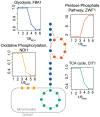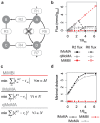Impact of stoichiometry representation on simulation of genotype-phenotype relationships in metabolic networks
- PMID: 23133362
- PMCID: PMC3486866
- DOI: 10.1371/journal.pcbi.1002758
Impact of stoichiometry representation on simulation of genotype-phenotype relationships in metabolic networks
Abstract
Genome-scale metabolic networks provide a comprehensive structural framework for modeling genotype-phenotype relationships through flux simulations. The solution space for the metabolic flux state of the cell is typically very large and optimization-based approaches are often necessary for predicting the active metabolic state under specific environmental conditions. The objective function to be used in such optimization algorithms is directly linked with the biological hypothesis underlying the model and therefore it is one of the most relevant parameters for successful modeling. Although linear combination of selected fluxes is widely used for formulating metabolic objective functions, we show that the resulting optimization problem is sensitive towards stoichiometry representation of the metabolic network. This undesirable sensitivity leads to different simulation results when using numerically different but biochemically equivalent stoichiometry representations and thereby makes biological interpretation intrinsically subjective and ambiguous. We hereby propose a new method, Minimization of Metabolites Balance (MiMBl), which decouples the artifacts of stoichiometry representation from the formulation of the desired objective functions, by casting objective functions using metabolite turnovers rather than fluxes. By simulating perturbed metabolic networks, we demonstrate that the use of stoichiometry representation independent algorithms is fundamental for unambiguously linking modeling results with biological interpretation. For example, MiMBl allowed us to expand the scope of metabolic modeling in elucidating the mechanistic basis of several genetic interactions in Saccharomyces cerevisiae.
Conflict of interest statement
The authors have declared that no competing interests exist.
Figures




Similar articles
-
Path finding methods accounting for stoichiometry in metabolic networks.Genome Biol. 2011;12(5):R49. doi: 10.1186/gb-2011-12-5-r49. Epub 2011 May 27. Genome Biol. 2011. PMID: 21619601 Free PMC article.
-
An insight to flux-balance analysis for biochemical networks.Biotechnol Genet Eng Rev. 2020 Apr;36(1):32-55. doi: 10.1080/02648725.2020.1847440. Epub 2020 Dec 9. Biotechnol Genet Eng Rev. 2020. PMID: 33292061 Review.
-
Evolutionary programming as a platform for in silico metabolic engineering.BMC Bioinformatics. 2005 Dec 23;6:308. doi: 10.1186/1471-2105-6-308. BMC Bioinformatics. 2005. PMID: 16375763 Free PMC article.
-
Including metabolite concentrations into flux balance analysis: thermodynamic realizability as a constraint on flux distributions in metabolic networks.BMC Syst Biol. 2007 Jun 1;1:23. doi: 10.1186/1752-0509-1-23. BMC Syst Biol. 2007. PMID: 17543097 Free PMC article.
-
Exploiting stoichiometric redundancies for computational efficiency and network reduction.In Silico Biol. 2015;12(1-2):55-67. doi: 10.3233/ISB-140464. In Silico Biol. 2015. PMID: 25547516 Free PMC article. Review.
Cited by
-
Genetic Optimization Algorithm for Metabolic Engineering Revisited.Metabolites. 2018 May 16;8(2):33. doi: 10.3390/metabo8020033. Metabolites. 2018. PMID: 29772713 Free PMC article.
-
Assessment of FBA Based Gene Essentiality Analysis in Cancer with a Fast Context-Specific Network Reconstruction Method.PLoS One. 2016 May 4;11(5):e0154583. doi: 10.1371/journal.pone.0154583. eCollection 2016. PLoS One. 2016. PMID: 27145226 Free PMC article.
-
Pathway thermodynamics highlights kinetic obstacles in central metabolism.PLoS Comput Biol. 2014 Feb 20;10(2):e1003483. doi: 10.1371/journal.pcbi.1003483. eCollection 2014 Feb. PLoS Comput Biol. 2014. PMID: 24586134 Free PMC article.
-
Dynamic epistasis under varying environmental perturbations.PLoS One. 2015 Jan 27;10(1):e0114911. doi: 10.1371/journal.pone.0114911. eCollection 2015. PLoS One. 2015. PMID: 25625594 Free PMC article.
-
Evaluating E. coli genome-scale metabolic model accuracy with high-throughput mutant fitness data.Mol Syst Biol. 2023 Dec 6;19(12):e11566. doi: 10.15252/msb.202311566. Epub 2023 Oct 27. Mol Syst Biol. 2023. PMID: 37888487 Free PMC article.
References
-
- Szappanos B, Kovács K, Szamecz B, Honti F, Costanzo M, et al. (2011) An integrated approach to characterize genetic interaction networks in yeast metabolism. Nat Genet 43: 656–662 doi:10.1038/ng.846. - DOI - PMC - PubMed
Publication types
MeSH terms
LinkOut - more resources
Full Text Sources
Molecular Biology Databases

